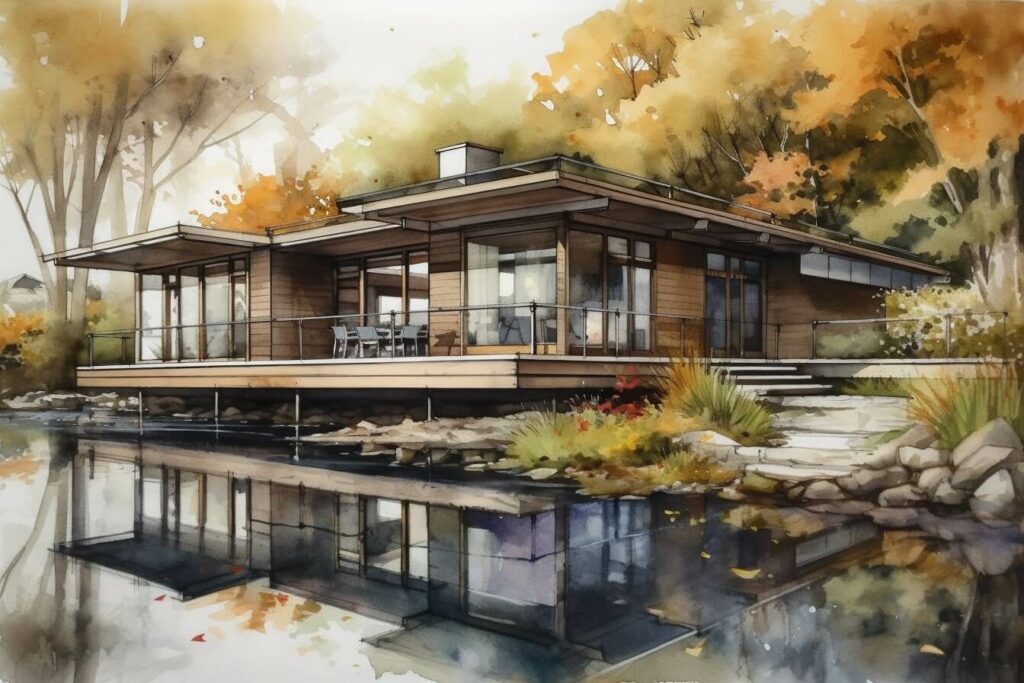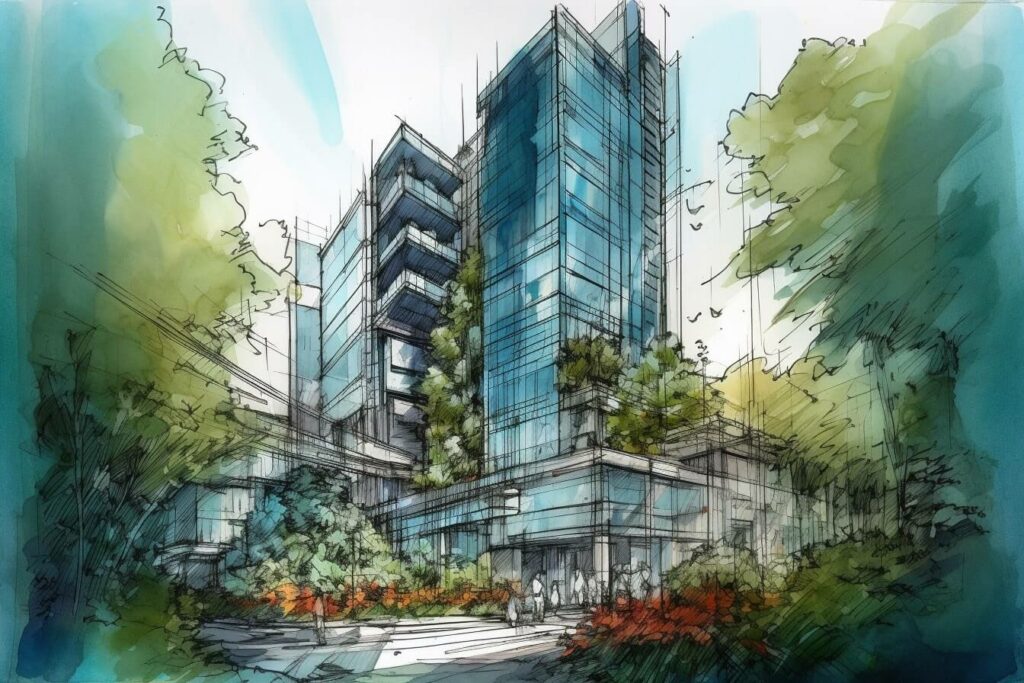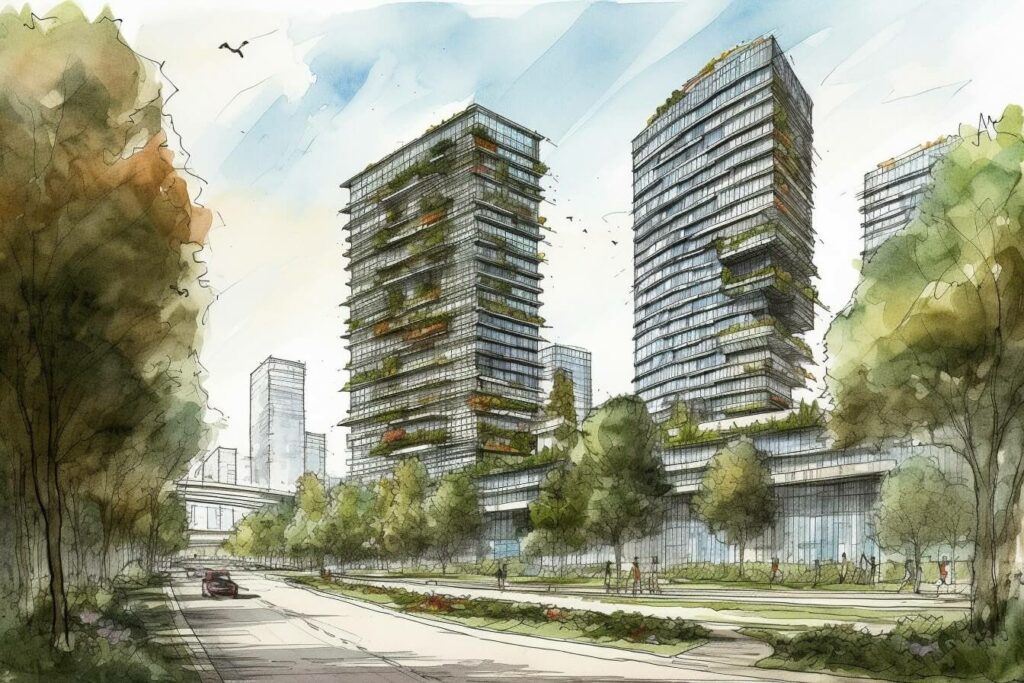Unlock Premium, Members-Only Content
Your source for the most relevant updates in sustainable construction
The concept of zero waste has gained traction as a solution to the growing waste problem faced by our planet. As architects, interior designers, and construction companies, you are uniquely positioned to reduce waste and foster a sustainable future significantly.
This article will delve into zero waste design, essential elements, strategies to achieve it, and some inspiring case studies. So, let’s embark on this journey towards a more sustainable built environment!

Understanding Zero Waste Design
Zero waste design is a holistic philosophy that strives to minimize waste generation by considering the entire lifecycle of materials and products.
This approach is based on sustainability, resource efficiency, and environmental responsibility, emphasizing the importance of creating a circular economy where resources are utilized efficiently, and waste is minimized.
Principles of Zero Waste Design
- Waste Prevention: The first principle of zero waste strategies is to prevent waste generation. This involves optimizing material usage, employing efficient construction techniques, and minimizing waste during design and construction.
- Resource Efficiency: This principle focuses on making the most of available resources by designing products, spaces, and buildings that use materials and energy efficiently, thus reducing waste and environmental impact.
- Circular Economy: A circular economy aims to keep resources in use for as long as possible by maximizing their value through reuse, recycling, and recovery. Zero waste design supports this concept by prioritizing using materials that can be easily recycled or repurposed.
- Adaptability and Flexibility: Designing spaces and structures that are adaptable and flexible ensures that they can be easily modified or repurposed as needs change. This extends the useful life of a building, reducing waste generation and resource consumption.
- Lifecycle Thinking: Considering the entire lifecycle of materials and products—from extraction to disposal—ensures that waste and resource consumption are minimized throughout the process. This involves selecting durable materials and designing for easy disassembly and recycling.
Unlock Premium, Members-Only Content
Your source for the most relevant updates in sustainable construction
Benefits of Zero Waste Design
- Reduced Environmental Impact: By minimizing waste generation, zero waste design significantly reduces the environmental impact of the built environment. This includes lowering greenhouse gas emissions, reducing resource consumption, and minimizing waste sent to landfills.
- Lower Costs Associated with Waste Management: By reducing waste generation during the design, construction, and operation phases, zero waste strategies helps save money on waste management costs, such as disposal fees and transportation.
- Enhanced Reputation and Marketability: Embracing zero-waste design principles can improve the reputation of architects, interior designers, and construction companies, making them more appealing to environmentally conscious clients and consumers.
- Compliance with Environmental Regulations: As environmental regulations become more stringent, adopting zero-waste design practices can help businesses stay ahead of the curve and ensure compliance with evolving regulations.
- Opportunities for Innovation: Zero waste design encourages innovation by challenging architects, interior designers, and construction companies to develop new materials, techniques, and strategies for reducing waste and creating sustainable spaces. This can lead to the development of cutting-edge solutions and unique design approaches, setting businesses apart from their competitors.
Key Elements of Zero Waste Design
Material Selection
Selecting the right materials is fundamental to the zero-waste design.
Critical considerations for material selection include:
Eco-friendliness: Choose materials with a low environmental impact, such as sustainably sourced timber, recycled metal, or rapidly renewable materials like bamboo.
Durability: Durable materials last longer, reducing the need for replacement and maintenance, which minimizes waste generation.
Recyclability: Opt for materials that can be easily recycled at the end of their life, such as metal, glass, or certain types of plastics.
Local sourcing: Use locally sourced materials to minimize transportation emissions and support the local economy whenever possible.
Design for Disassembly
Designing buildings and components with disassembly in mind is an essential aspect of zero-waste design. This approach enables the efficient reuse or recycling of materials when their useful life ends.
Critical considerations for designing for disassembly include:
Use of modular components: Utilize modular elements that can be easily removed, replaced, or reconfigured without causing damage to other parts of the structure.
Avoid adhesives and permanent connections: Opt for mechanical fasteners, such as screws and bolts, instead of adhesives, to facilitate disassembly.
Clear labeling and documentation: Clearly label components and provide documentation on disassembling them to make the process more straightforward for future users.
Modularity
Modular design principles are crucial for creating flexible spaces that adapt easily to changing needs.
Critical aspects of modularity in zero-waste design include:
Reconfigurable spaces: Design spaces with movable walls, modular furniture, and easily flexible layouts that can be reconfigured to accommodate different needs and functions.
Scalability: Create designs that can be easily expanded or contracted as needed, allowing for the efficient use of resources and minimizing waste.
Standardized components: Utilize standardized, interchangeable components to facilitate easy replacement, repair, and reuse.
Adaptability
Designing adaptable buildings and spaces is vital for ensuring longevity and minimizing waste.
Critical considerations for adaptability in zero waste design include:
Flexible layouts: Create open floor plans and movable partitions that can be easily reconfigured to accommodate changing needs and technologies.
Upgradability: Incorporate building systems and components that can be easily updated or replaced, such as lighting fixtures, HVAC systems, and plumbing fixtures.
Design for evolving technologies: Consider how future technologies may impact the building’s design and incorporate provisions for integrating new systems or features as they become available.

Strategies for Zero Waste Design
Waste Prevention
Placing a strong emphasis on waste prevention through meticulous design and construction practices helps to minimize waste generation.
Waste prevention strategies include:
Lean construction: Implement lean construction methodologies to streamline processes, reduce waste, and improve efficiency.
Efficient material use: Optimize material usage by minimizing offcuts, using standard sizes, and employing computer-aided design tools to reduce waste during construction.
Prefabrication: Utilize prefabricated components or modular construction techniques to minimize on-site waste and improve overall construction efficiency.
Reuse and Recycling
Encouraging the reuse and recycling of materials and components is a vital strategy for conserving resources and reducing waste.
This can be achieved by:
Repurposing existing structures: When possible, renovate or retrofit existing buildings instead of constructing new ones, thus preserving the embodied energy and materials.
Using reclaimed materials: Incorporate reclaimed materials, such as salvaged wood, bricks, or metal, in new projects to reduce the demand for new resources.
Incorporating recycled content: Use recycled products, such as recycled glass, rubber, or plastic, to promote a circular economy and minimize waste.
Material Recovery
Designing with material recovery in mind ensures that valuable resources can be recovered once a building ends its life. Critical strategies for material recovery include:
Deconstruction plans: Develop plans for constructing a building, identifying materials and components that can be salvaged, reused, or recycled.
Design for disassembly: Design structures and components to be easily disassembled, facilitating efficient material recovery at the end of their life.
Selecting easily recyclable materials: Choose materials that can be readily recycled, such as aluminum, steel, or certain plastics, to promote material recovery and minimize waste.
Energy Efficiency
Energy-efficient design not only helps to reduce waste related to energy consumption but also contributes to a more sustainable built environment.
Critical strategies for energy-efficient design include:
Passive design strategies: Incorporate passive design elements, such as natural ventilation, daylighting, and thermal mass, to minimize energy consumption and reduce the need for mechanical systems.
Efficient building systems: Use energy-efficient systems, such as high-performance HVAC, lighting, and water systems, to minimize energy use and waste.
Renewable energy sources: Integrate renewable energy sources, such as solar panels, wind turbines, or geothermal systems, to power buildings and reduce reliance on non-renewable resources.
Unlock Premium, Members-Only Content
Your source for the most relevant updates in sustainable construction
Case Studies
Case Study 1: Example of Zero Waste Design in Architecture
The Bullitt Center, Seattle, Washington
The Bullitt Center, a six-story commercial building in Seattle, Washington, is an outstanding example of zero-waste design in architecture. Designed by the Miller Hull Partnership, the building was constructed to meet the rigorous standards of the Living Building Challenge.
Some of its key sustainable features include:
- Green roof: The rooftop garden helps manage stormwater runoff, insulates the building, and provides a habitat for local wildlife.
- Rainwater harvesting: The building collects and treats rainwater for non-potable applications, reducing the demand for municipal water resources.
- Photovoltaic panels: A rooftop solar array generates enough energy to meet the building’s annual energy needs, making it self-sufficient.
- Design for disassembly: The building incorporates modular components and materials that can be easily recycled or reused, allowing for efficient disassembly and material recovery at the end of its life.
Case Study 2: Example of Zero Waste Design in Interior Design
Google Campus, Dublin, Ireland
The Google Campus in Dublin, Ireland, showcases zero-waste design principles in its interior spaces. Designed by architectural firm Camenzind Evolution in collaboration with local partners, the project aimed to create a sustainable and flexible work environment.
Some key zero-waste design elements include:
- Recycled materials: The project prioritized using recycled materials, such as reclaimed wood for wall cladding and recycled carpets for flooring.
- Flexible and adaptable spaces: The office spaces were designed with movable partitions and modular furniture, allowing for easy reconfiguration to accommodate changing work patterns and team sizes.
- Energy efficiency: The campus incorporates energy-efficient lighting, HVAC, and building automation systems to minimize energy consumption and waste.
- Biophilic design: Natural elements, such as living walls and abundant greenery, are integrated throughout the campus, improving indoor air quality and providing a healthier work environment.
These case studies demonstrate how architects and interior designers can successfully implement zero-waste design principles in their projects, creating sustainable and adaptable spaces that minimize waste and environmental impact.
Challenges and Opportunities
Adopting zero-waste design principles offers numerous benefits, but architects, interior designers, and construction companies face several challenges.
The followings are some of the most common obstacles and the opportunities they present:
Initial Costs
Implementing sustainable practices and materials may involve higher upfront costs than conventional methods. However, the long-term financial benefits of reduced waste management costs, lower energy consumption, and decreased maintenance expenses can offset the initial investment. As the demand for sustainable design grows, economies of scale may also help reduce costs for eco-friendly materials and technologies.
Complex Regulations
Navigating the intricate web of environmental regulations and building codes can be challenging for professionals in the building industry. However, embracing zero-waste design principles can position businesses as industry leaders, ensuring compliance with current regulations and staying ahead of future changes. This proactive approach can enhance a company’s reputation and marketability.
Continuous Innovation
The ever-evolving nature of sustainable design requires continuous innovation to develop new materials, techniques, and strategies that reduce waste and promote a circular economy. This challenge presents an opportunity for businesses to become pioneers in their field, setting them apart from competitors and attracting environmentally conscious clients.
Collaboration and Education
Successfully implementing zero-waste design often requires collaboration between various stakeholders, including architects, designers, contractors, and suppliers. This collaboration can be challenging due to differing perspectives, goals, and priorities. However, fostering a culture of collaboration and education can lead to the development of innovative solutions and help create a shared understanding of the importance of sustainable design.
Changing Mindsets
One of the most significant challenges in adopting zero-waste design is shifting the mindset of industry professionals, clients, and end-users. This involves overcoming resistance to change and convincing stakeholders of the long-term benefits of sustainable design.
By showcasing successful projects and demonstrating the tangible advantages of zero-waste design, industry professionals can help change perceptions and drive the adoption of sustainable practices.
By addressing these challenges and seizing their opportunities, architects, interior designers, and construction companies can contribute to the growth of zero-waste design and help create a more sustainable future for the built environment.
Zero waste design: Conclusion
Zero waste design represents a vital approach for architects, interior designers, and construction companies to tackle the worldwide waste crisis and contribute to a more sustainable built environment.
By comprehending and implementing key elements and strategies, professionals in the industry can make a significant difference in how we approach building design and construction. These crucial aspects include material selection, design for disassembly, modularity, adaptability, waste prevention, reuse and recycling, material recovery, and energy efficiency.
Incorporating zero-waste design principles helps create structures that minimize waste throughout their entire lifecycle while enhancing the well-being of occupants and reducing the environmental impact. Through continuous innovation, collaboration, and education, industry professionals can drive change and work together to overcome the challenges associated with sustainable design.
As we strive towards a future where buildings and spaces embody zero-waste design principles, we can mitigate the effects of our waste crisis and foster a healthier and more resilient world for future generations.

Zero waste design: FAQs
What is zero waste design?
Zero waste design is a philosophy that aims to eliminate waste generation by considering the entire lifecycle of materials and products, focusing on sustainability, resource efficiency, and environmental responsibility.
Why is zero waste design important?
Zero waste strategies address the growing waste problem, reduce environmental impact, and promote a sustainable built environment. It also offers cost savings, compliance with environmental regulations, and marketability for architects, interior designers, and construction companies.
What are the critical elements of zero-waste design?
The critical elements of zero waste design include material selection, design for disassembly, modularity, and adaptability. These elements ensure efficient use of resources, facilitate maintenance and repairs and allow for easy repurposing or recycling of materials at the end of their useful life.
What strategies can be employed to achieve zero waste design?
Strategies for zero waste strategies include waste prevention through lean construction and efficient material use, reuse and recycling of materials and components, recovery by designing for disassembly and using easily recyclable materials, energy efficiency through passive design strategies, efficient building systems, and renewable energy sources.
Can you provide examples of successful zero-waste design projects?
The Bullitt Center in Seattle, Washington, is an example of zero waste design in architecture, incorporating features such as a green roof, rainwater harvesting, and photovoltaic panels, as well as being designed for disassembly. The Google Campus in Dublin, Ireland, exemplifies zero-waste design in interior spaces, prioritizing using recycled materials, flexible and adaptable office spaces, and energy-efficient systems.
Unlock Premium, Members-Only Content
Your source for the most relevant updates in sustainable construction
If you need our services in the Portuguese language, click here.